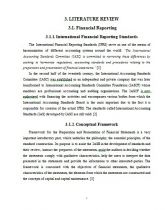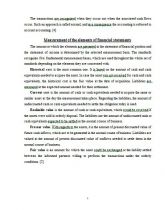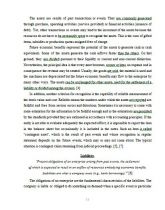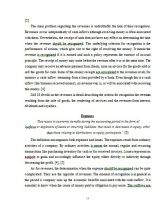Hledej
Zobraz:
Univerzity
Kategorie
Rozšířené vyhledávání
12 662
projektů
Home » Bakalářská práce » Analysis of Financial Statements Prepared according to International Financial Reporting Standards IFRS
Analysis of Financial Statements Prepared according to International Financial Reporting Standards IFRS
| Přípona .doc |
Typ bakalářská práce |
Stažené 0 x |
| Velikost 3,8 MB |
Jazyk anglický |
ID projektu 3667 |
| Poslední úprava 16.06.2014 |
Zobrazeno 1 989 x |
Autor: eliseus |
 Sdílej na Facebooku
Sdílej na Facebooku |
||
| Detaily projektu | ||
- Cena:
14 Kreditů - kvalita:
92,3% -
Stáhni
- Přidej na srovnání
- Univerzita:Česká zemědělská univerzita v Praze
- Fakulta:Provozně ekonomická fakulta
- Kategorie:Ekonomika » Ekonomie
- Předmět:Ekonomie
- Studijní obor:-
- Ročník:-
- Formát:MS Office Word (.doc)
- Rozsah A4:91 stran
Accounting is a structured and sophisticated system for recording business operations in monetary units according to a given group of rules and norms. The operations have unquestionably economic consequences and therefore the role of accountancy as a tool for monitoring, recording and subsequent exposure of financial activities occurring in the accounting entity is indispensable. Then, the main purpose is to gather information about the economic events and transactions, their summarizing and submitting an overall report on financial situation and financial performance of the company. If the objective of keeping the records is to provide such information, particularly to external users, then it is called financial accounting. However, the internal users like managers and even the employees may benefit. Among the external groups involved in the company's activities belong, for example, the investors, owners, tax authority offices, suppliers, customers and trade associations.
Routine accounting records take place during the accounting period; their accuracy undergoes necessary scrutiny and in the end, the works on preparation of financial statements come about. The statements should encompass all above-mentioned information, which is further supported by notes and often by annual report of the company.
Klíčová slova:
Accounting discretion
Financial analysis
investor
suppliers
economic events
Obsah:
- 1. Introduction 1
2. The goal and methodology 3
3. Literature review 4
3.1. Financial reporting 4
3.1.1. International financial reporting standards 4
3.1.2. Conceptual framework 4
3.1.3. The statement of financial position 7
3.1.4. Statement of income and comprehensive income 15
3.1.5. Statement of changes in equity 20
3.1.6. Footnotes 21
3.1.7. Statement of cash flows 21
3.1.8. Constraints of financial statements 24
3.1.9. Accounting discretion 26
3.2. Financial analysis 30
3.2.1. The objective of financial analysis 30
3.2.2. The users of financial analysis 31
3.2.3. Sources of information 33
3.2.4. Techniques of financial analysis 34
4. Case study 44
4.1. Selection of a company 44
4.2. Basic information 44
4.3. Financial reporting 45
4.4. Analysis of statement of comprehensive income 46
4.4.1. Horizontal common-size analysis 46
4.4.2. Vertical common-size analysis 47
4.4.3. Trend analysis 49
4.5. Analysis of statement of financial position 51
4.5.1. Horizontal common-size analysis 51
4.5.2. Vertical common-size analysis 52
4.5.3. Trend analysis 54
4.6. Working capital 56
4.7. Ratio analysis 57
4.7.1. Liquidity ratios 57
4.7.2. Solvency ratios 59
4.7.3. Profitability ratios 60
4.7.4. Activity ratios 62
5. Outcomes assessment 64
6. Conclusion 66
7. List of resources 68
8. List of abbreviations 70
9. List of charts 71
10. List of tables 71
11. Appendix 72
11.1. List of appendices 72
Zdroje:
- International Financial Reporting Standards: as issued at 1 January 2009. United Kingdom, London: International Accounting Standards Board, 2009. 2880 p. ISBN 978-1-905590-90-2
- KOVANICOVÁ, Dana. Abeceda účetních znalostí pro každého. Nineteenth updated edition. Prague: Polygon, 2009. 400 p. ISBN 978-80-7273-156-5
- EPSTEIN, Barry J., JERMAKOWICZ, Eva K. IFRS 2010: Implementation and Application of International Financial Reporting Standards. 7th edition. Hoboken, New Jersey: John Wiley & Sons, 2010. 1328 p. ISBN 978-0470-45323-0
- PELÁK, Jiří. Účetnictví v Příkladech - repetitorium k základům z účetnictví. Second revision. Prague: Oeconomica, 2009. 200 p. ISBN 978-80-245-1507-6
- DVOŘÁKOVÁ, Dana. Finanční účetnictví a výkaznictví podle mezinářodních standardů IFRS. Second, supplemented and updated edidtion. Brno: Computer Press, a. s., 2009. 329 p. ISBN 978-80-251-1950-1
- ROBINSON, Thomas R., GREUNING, Hennie van, HENRY, Elaine, BROIHAHN, Michael A. International Financial Statement Analysis. First edition. Hoboken, New Jersey: John Wiley & Sons, 2008. 864 p. ISBN 978-0-470-28766-8
- HINKE, Jana. Účetní systém IAS/IFRS. First edition. Prague: Kernberg Publishing, 2007. 200 p. ISBN 978-80-903962-2-7
- GIBSON, Charles H. Financial Reporting and Analysis: Using Financial Accounting Information. 8th edition. The United States of America, Mason: South Western Publishing Company, 2000. 672 p. ISBN 978-0324023534
- MRKVIČKA, Josef, KOLÁŘ, Pavel. Finanční analýza. Second updated edition. Prague: ASPI, a. s., 2006. 228 p. ISBN 80-7357-219-2
- RŮČKOVÁ, Petra. Finanční analýza: metody, ukazatele, využití v praxi. Second updated edition. Prague: GRADA Publishing, a. s., 2008. 120 p. ISBN 978-80-247-2481-2
- ALEXANDR, David, BRITTON, Anne, JORISSEN, Ann. International Financial Reporting and Analysis. Second Edition. London: Thomson Learning, 2005. 768 p. ISBN 978-1-84480-201-2
- MEIGS, Robert F., WILLIAMS, Jan R., HAKA, Susan F., BETTNER, Mark S. Accounting: The Basis for Business Decisions. Eleventh edition. The United States of America: McGraw-Hill, 1999. 1104 p. ISBN 0-07-289709-0
- KISLINGEROVÁ, Eva, HNILICA, Jiří. Finanční Analýza - krok za krokem. Second edition. Prague: C. H. Beck, 2008. 135 p. ISBN 978-80-7179-713-5
- GIBSON, Charles H. Financial Reporting and Analysis: Using Financial Accounting Information. 8th edition. The United States of America, Mason: South Western Publishing Company, 2000. 672 p. ISBN 978-0324023534
- HELFERT, Erich A. Financial Analysis: Tools and Techniques: A Guide for Managers. First edition. The United States of America: McGraw-Hill, 2001. 480 p. ISBN 0-07-137834-0
- GITMAN, Lawrence J., ZUTTER, Chad J. Principles of Managerial Finance. 13th edition. The United States of America: Prentice Hall, 2011. 944 p. ISBN 978-0136119463
- TAULLI, Tom. The EDGAR Online Guide to Decoding Financial Statements - Tips, Tools, and Techniques for Becoming a Savvy Investor. The United States of America: J. Ross Publishing, 2004. 312 p. ISBN 978-1932159288
- PEGAS SA annual reports



